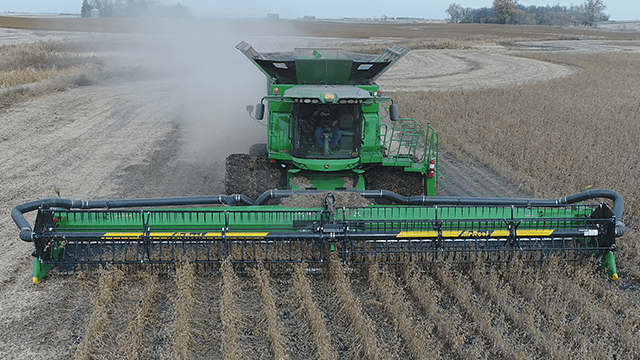Have you seen those spaceship looking things that farmers have been adding to their headers? What are they and why are they so great? We asked Dean Tong, a product expert at Crary® Ag to tell us more about the air systems we’re seeing more and more of on combine headers.
How Does a Wind System™ Work?
A Wind System provides a constant high-velocity stream of air that is positioned over the cutter bar on a soybean header. This air stream keeps the crops feeding evenly into the combine by pushing it back toward the auger or right onto the draper belt. Yes, Wind Systems work great for draper heads too! The high-power fan providing this air stream is securely mounted on the back of the header and can be gearbox or belt driven.
What is the Benefit of Adding a Wind System?
Today’s changing markets battle mixed weather patterns that bring high winds, drought or too wet of conditions. While there are plenty of unknowns right now, growers can still maximize yield by fighting back against the predictable issues. Wind Systems are designed to catch many of the known issues like shatter loss, bunching crop, short beans and more, all while ensuring as many beans get to the hipper as possible. Crary’s Wind Systems have shown an average yield increase of about 2-3 bushels per acre. Some growers and operators have claimed over 4 bushel yield increases between fields with air on vs. air off.
Reduce Shatter Loss
Air reduces normal shatter loss by catching the soybeans before they can bounce out. This in turn will also nearly eliminate volunteer crop. No matter the height of your beans, shatter loss is inevitable. Blowing them back to where they need to be means more money in your pocket.
Eliminate Bunching Crop on the Header
Most owners and operators of Wind Systems report higher ground speeds due to the fact that they no longer have to wait for bunched crop to clear the platform. Properly positioned high-velocity air quickly eliminates bunching by moving the entire stalk back to the auger or draper belt and right into the combine.
Save Those Short Beans
We can’t control the weather – it would be great if we could! Dry or too wet of conditions can create the dreaded short bean. Before adding air on headers, short beans meant spending more time in the field by slowing down, hugging the cutter bar as close to the dirt as possible, and hoping that the majority of the stalks fell toward to the header so they’d push themselves up into the combine. With a Wind System, short beans are saved with a boost from some friendly air.
Make More Money
With faster ground speeds come higher profits in time saved and reduced fuel expenses. When comparing the market price of soybeans and the verified yield increase from adding air to a header, an air system can pay for itself in one season, depending on the number of acres harvested. Not only does a Wind System save you money, it makes you money. Talk about a winning combo for ROI!
But are they easy to use?
Absolutely. With lengths to match your header, wireless controls, and simple annual maintenance, you’ll wonder why you waited to add the power of air. Install can usually be completed in a day with a few people. Most systems can be added directly to your existing header. For example, the Crary Wind System can be added to any complete soybean header. A durable and lightweight, painted aluminum manifold with gusseted drop tubes are mounted on the front of the header and will not interfere with the rotation or fingers on the existing reel (this is that spaceship looking part). The manifolds are supported by heavy duty flanged joints so that no cables are run through the manifold, potentially disrupting air performance. While this entire setup looks like it is from out of this world, it is lightweight, only takes about 1 HP per foot to operate, and makes your header look pretty sweet. Think of it as aviators for your combine.
What if I grow more than just soybeans?
Air is versatile. Legumes and cereal grain can all benefit. Types of crop and the condition of the crop are not a concern for air system operators. Many report moving between fields while making no adjustments to their header. The benefits of high velocity air are being realized in many different crop harvests: wheat, lentils and beans are just a few.
Growers across the country are adding the power of air to their headers and harnessing the benefits. In a world where every bean counts, it seems like a no-brainer.





